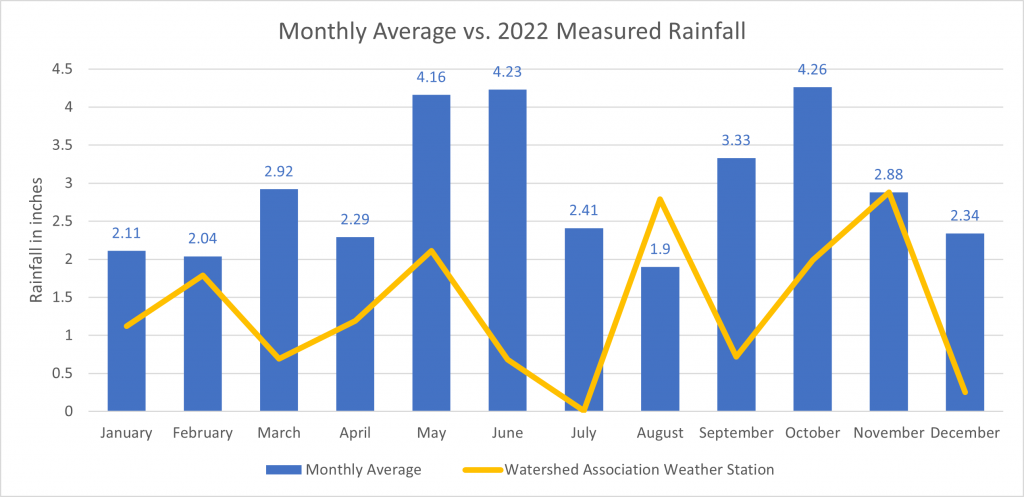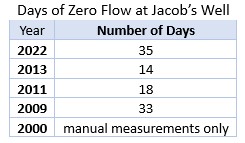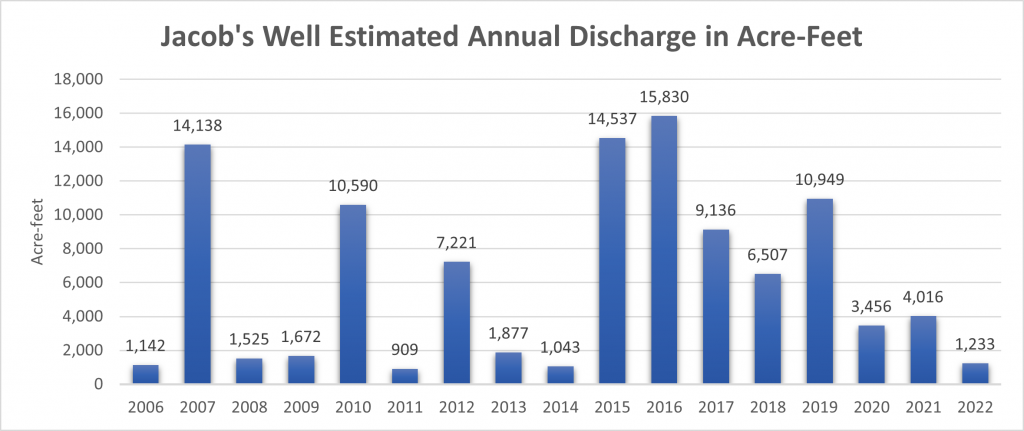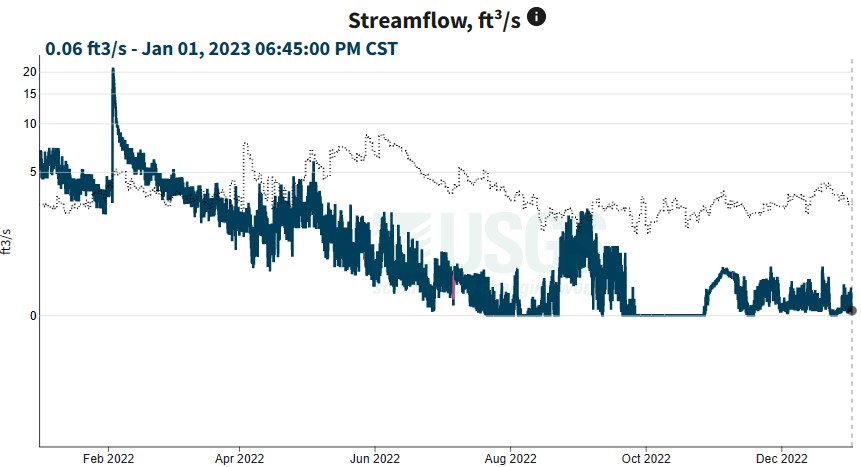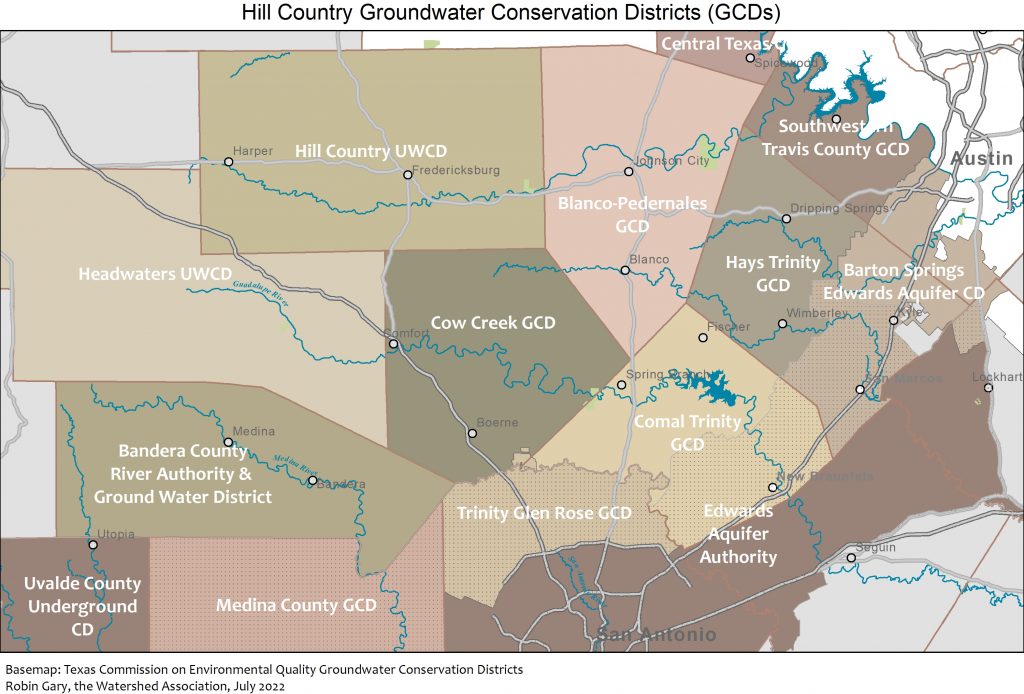Rainfall
2022 was a dry year. According to the Watershed Association weather station, the Jacob’s Well area received a total of 16.2 inches of rain for the year. Historic monthly rainfall records for Blanco, Texas show an annual average of 34.87 inches, which would mean our area is experiencing a 16.3 inch rainfall deficit for 2022.
The 2022 rainfall deficit has lasting effects that will continue into 2023. In the Wimberley Valley Weather Summary for 2022, comparisons for 2015–2022 by Raymond Schiflett, several statistics stand out in terms of the limited recharge the local groundwater systems received (Wimberley View, 1/4/23). Schifflett reports 0 days of rainfall over 2 inches in 2022. and states that 2022 was the fourth driest year in the past 35 years. Soaking rains saturate soils and allow for runoff–with no runoff, no water can make its way through faults, fractures and caves into the groundwater system. No recharge and continued pumpage lower water levels in aquifers, and ultimately impact spring flow at springs like Jacob’s Well, Park Spring, and Pleasant Valley Springs, which provide important baseflow for Cypress Creek and the Blanco River.
Spring Flow and Streamflow
Middle Trinity springs in western Hays County were severely impacted by drought and groundwater pumpage in 2022. USGS reports that Jacob’s Well had a daily average of 0 cubic feet per second (CFS) for 35 days in 2022. This was the fifth year Jacob’s Well stopped flowing in recent history. Manual flow measurements confirmed 2000 was the first time Jacob’s Well stopped flowing, but continuous flow monitoring at the USGS gauge since 2005 records the durations for four additional years.
Springs such as Jacob’s Well provide important baseflow to area creeks and rivers, which in turn flow downstream and contribute recharge to downstream aquifers (such as the Edwards Aquifer). Estimating annual discharge for Jacob’s Well shows wide variation in wet year and dry year contributions. In the graph below, the daily mean discharge in cubic feet per second was converted to acre-feet per day, then the sum for the year was calculated. In 2022, Jacob’s Well contributed approximately 1,200 acre-feet of baseflow (fourth lowest year for annual discharge). The highest annual discharge was over 15,800 acre-feet in 2016; and the lowest annual discharge was 908 acre-feet in 2011.
Spring flow was well below average for much of the latter half of the year. Low spring flow created water quality concerns at Jacob’s Well and downstream at Blue Hole, which lead to Jacob’s Well Natural Area and Blue Hole Regional Park suspending swimming. The County suspended swimming at Jacob’s Well on June 29, 2022 due to high bacteria counts brought about by heavy recreational use and low flow. The City of Wimberley suspended swimming on August 1, 2022 for similar concerns.
Importance of Conservation
Please continue to conserve. Coordinated water conservation is key to preserve groundwater availability, spring flow, and water supplies. All of the Hill Country is experiencing rainfall deficits which leading to pronounced drought conditions in our area.
Most communities in the Hill Country are groundwater-dependent, so drought conditions are particularly troublesome for water supplies, recreation-based tourism, and springs and rivers. Please follow groundwater district drought restrictions and local water provider drought water use guidance. Limit outdoor irrigation and conserve water indoors. Identify and fix leaks. Conserve water to prolong water supplies until rainfall can replenish our aquifers. While we can’t control the weather, we can conserve water and look for innovative ways to use alternate supplies (like site-harvested supplies—rainwater and AC condensate) to lessen impacts of pumping. While each aquifer behaves differently, all groundwater is limited and deserves to be used wisely. For more information on native landscapes, rainwater harvesting, leak identification tips and more, visit the Home Owner Resource page.
No matter what area agencies call their drought declaration, coordinated water conservation is important to preserve groundwater availability, spring flow, and water supplies.
| Agency | Drought Stage | Date Declared | Details |
| Barton Springs Edwards Aquifer CD | Stage III Critical Drought (minimum of 30% Reduction) | Oct 2022 | Press Release, 10/20/2022 |
| Blanco Pedernales GCD | Stage 3 – 20-50% Reduction in pumping | August 2022 | Press Release, August 2022 |
| Comal Trinity GCD | |||
| Cow Creek GCD | Stage 3 – 30% Reduction in pumpage | June 2022 | Public Notice, 6/14/2022 |
| Hays Trinity GCD | 30% Curtailment for Jacob’s Well GMZ, 40% for remainder of the District | July 2022 | Board Order, 7/31/22 |
| Edwards Aquifer Authority | San Antonio Pool is in Stage 3 – 35% Reduction | June 2022 | Press Release, 6/13/22 |
[Updated 1/28/2022]
